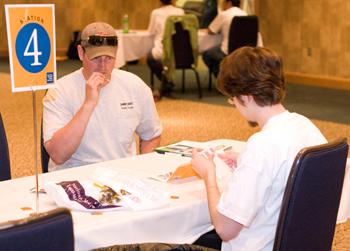Students donate gift of life at bone marrow registration
May 11, 2008
The National Marrow Donation Program was on campus Thursday to find students willing to help people in need. The NMDP asks donors to give their blood or bone marrow and raises awareness for leukemia, aplastic anemia, sickle cell anemia and other blood-related diseases.
The “Thanks, Mom” program funded the Washburn campaign so that students wouldn’t have to pay the $52 necessary to process a tissue sample. The sample is needed for the NMDP registry in order to connect a possible donor with a patient waiting for blood or bone marrow.
“Thanks, Mom” is just one program which makes increasing the number of donors in the NMDP registry easier. The campaign is in its third year. Why the name? All those who didn’t get Mom a Mother’s Day gift but were at the Washburn Room in the Memorial Union on Thursday, could instead tell her that they gave life – the life that she gave – to help save lives.
The NMDP’s goal this year is to recruit 46,000 new donors. Its database currently has 7 million donors, though 5 million of those are of Caucasian descent. LaGail Chism, the event’s coordinator, described the process to potential donors at one of the stations during the sign-up process.
“All potential donors are needed,” said Chism. “Minority donors are especially needed.”
To register with the National Registry is a relatively simple process. The applicant fills out the necessary forms and gives consent to stay on the registry until age 61 or a severe illness comes up. Then the applicant watches a video describing actual situations of real donors and the patients they’ve helped. Finally, a cheek swab or blood donation is taken to begin the matching process.
The bone marrow or the stem cells that have been donated will be shipped to the patient. After a year of receipt, there is a possibility for a patient-donor meeting. Families are most often the best option for the donor. The family is tested first because of the genetic similarity. Money for the project comes from monetary contributions or contributions of tissue and blood donations.
Stephanie Dall, freshman, discovered the donation process through an online ad on Facebook, and said that her primary motivation for donating was that she just wanted to help people.
Tyler Goetz, president of the Washburn premed chapter of the American Medical Student Association, thinks the drive is a good project to get people, especially students, involved. Goetz says Topeka hasn’t had a major marrow donation program on this scale and that 65 percent of the volunteers are Washburn students.
“Six-thousand patients check the [NMDP] each day,” said Goetz. “There’s not enough people in the registry. We need people from all different backgrounds to donate.”
For more information about the NMDP, visit www.marrow.org.



